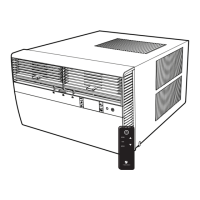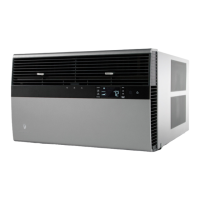Do you have a question about the Friedrich KCS12A10A and is the answer not in the manual?
General safety warnings and hazard symbols used in the manual.
Details hazards related to personal injury or death during operation and service.
Outlines electrical safety precautions and warnings for installation and service.
Covers specific hazards related to refrigeration, mechanical components, fire, and water damage.
Explains the structure and meaning of the model number.
Explains the structure and meaning of the serial number.
Details circuit ratings, breaker/plug types, and receptacle requirements.
Covers electrical hazards, LCDI power cord function, and testing procedures.
Lists diagnostic codes, their problems, and corresponding control board actions.
Addresses common issues like unit not operating, tripping breakers, or LCDI cord trips.
Covers insufficient cooling/heating, unit running too much, and compressor not running.
Addresses fan motor issues, poor cooling, unit not running, frozen coils, and continuous compressor run.
Details problems specific to heating cycles like uneven temperature or lack of heat.
Diagnoses heating cycle issues based on refrigerant pressures and conditions.
Provides a flowchart for diagnosing electrical issues in heat pump heating.
Diagnoses cooling cycle issues based on refrigerant pressures and conditions.
Covers testing compressor voltage, running amperage, and overload protectors.
Details resistance tests, ground tests, and checking compressor efficiency.
Lists important considerations and requirements for working with R-410A refrigerant.
Explains the importance of proper refrigerant charge and methods for charging.
Describes symptoms and checks for an undercharged refrigerant system.
Describes symptoms and checks for an overcharged refrigerant system.
Explains types of restrictions and how to diagnose them.
Details the weighed-in charge method for sealed system repairs.
Provides steps for replacing a compressor, including leak testing and evacuation.
Special procedures for compressor replacement after a burnout, including system flushing.
Step-by-step instructions for replacing the reversing valve, including brazing precautions.
General safety warnings and hazard symbols used in the manual.
Details hazards related to personal injury or death during operation and service.
Outlines electrical safety precautions and warnings for installation and service.
Covers specific hazards related to refrigeration, mechanical components, fire, and water damage.
Explains the structure and meaning of the model number.
Explains the structure and meaning of the serial number.
Details circuit ratings, breaker/plug types, and receptacle requirements.
Covers electrical hazards, LCDI power cord function, and testing procedures.
Lists diagnostic codes, their problems, and corresponding control board actions.
Addresses common issues like unit not operating, tripping breakers, or LCDI cord trips.
Covers insufficient cooling/heating, unit running too much, and compressor not running.
Addresses fan motor issues, poor cooling, unit not running, frozen coils, and continuous compressor run.
Details problems specific to heating cycles like uneven temperature or lack of heat.
Diagnoses heating cycle issues based on refrigerant pressures and conditions.
Provides a flowchart for diagnosing electrical issues in heat pump heating.
Diagnoses cooling cycle issues based on refrigerant pressures and conditions.
Covers testing compressor voltage, running amperage, and overload protectors.
Details resistance tests, ground tests, and checking compressor efficiency.
Lists important considerations and requirements for working with R-410A refrigerant.
Explains the importance of proper refrigerant charge and methods for charging.
Describes symptoms and checks for an undercharged refrigerant system.
Describes symptoms and checks for an overcharged refrigerant system.
Explains types of restrictions and how to diagnose them.
Details the weighed-in charge method for sealed system repairs.
Provides steps for replacing a compressor, including leak testing and evacuation.
Special procedures for compressor replacement after a burnout, including system flushing.
Step-by-step instructions for replacing the reversing valve, including brazing precautions.
| Cooling Capacity | 12, 000 BTU |
|---|---|
| Type | Window Air Conditioner |
| Fan Speeds | 3 |
| Noise Level | 52 dB |
| Power Supply | 115V/60Hz |
| Voltage | 115V |
| Refrigerant | R-410A |
| Amps | 10.8 A |












